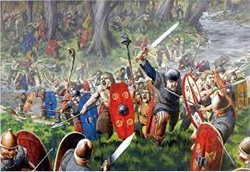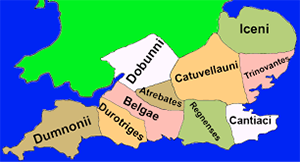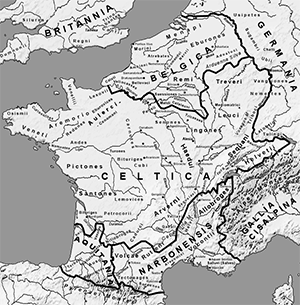The Belgae
The Belgae predated the Romans, in both Gaul and in Britain, establishing living and trade networks in northwest Europe and ranging across what was later named the English Channel to first raid and then settle among Celtic tribes in southern Britain. The Greek geographer Strabo wrote that the Belgae controlled territory from the Rhine to the Loire. Most of what is known of the Belgae comes from the writings of the Roman Julius Caesar, who led armies that conquered the Belgae but also made a study of them. Caesar and others named the Belgae tribes as follows:

Caesar and Rome had designs on Gaul and moved armies into and through area in the 1st Century B.C. The Romans moved cautiously because the Belgae were known, from testimony given by their Celtic and Germanic neighbors, to be effective and efficient in warfare. Caesar's forces began their conquest of the Belgae in 57 B.C. Rome had forged an alliance with the Gallic tribe the Aedui, and it was that people who proved the vanguard of Rome's offensive, invading the territory of the Bellovaci as Caesar's forces advanced. An initial battle went the way of the Romans, and they advanced to take on the Suessiones, at the town of Soissons. Once the Romans had deployed their numerous and deadly-looking siege engines, the Suessiones surrendered. Word spread of the Roman might, and surrenders came next from the Bellovaci and the Ambiani. Choosing to fight were the Nervii, who hit the advancing Romans hard with a sneak attack near the river Sabis. Caesar himself took up arms and stormed to the front line, rallying his troops; Rome was eventually victorious. Others who chose to fight were the Atuatuci, Eburones, Menapii, and Morini, all of whom banded together in 53 B.C. Rome was again victorious. A cadre of Belgic fighters joined the Gallic leader Vercingetorix in his uprising against Rome. Caesar and his men prevailed, and Rome declared that the Belgae were part of the newly proclaimed Gallia Belgica. 
Meanwhile, Belgic people from a handful of tribes had crossed the water off the coast of northwestern Europe and settled in what is now southern England, with a capital at Venta Balgarum, what is now Winchester, and a major center at Aqvae Calidae, what is now Bath. Among those tribes were the Ambiani, Atrebates, and Suessiones, whose king Diviciacus ruled over territory on both sides of the water. One innovation that the Belgae brought with them to Britain was the heavy plow, which proved eminently useful in some parts of the south that had been untillable. Caesar, in his invasions of 55 B.C. and 54 B.C., encountered these tribes as well; the Romans under Claudius, a century later, conquered them. |
|
Social Studies for Kids
copyright 2002–2025
David White



 The Belgae were a collection of Celtic and Germanic tribes of people living in what the Romans called Gaul and what became Belgium, the Netherlands, and England for a few centuries either side of the B.C./A.D. divide.
The Belgae were a collection of Celtic and Germanic tribes of people living in what the Romans called Gaul and what became Belgium, the Netherlands, and England for a few centuries either side of the B.C./A.D. divide.
